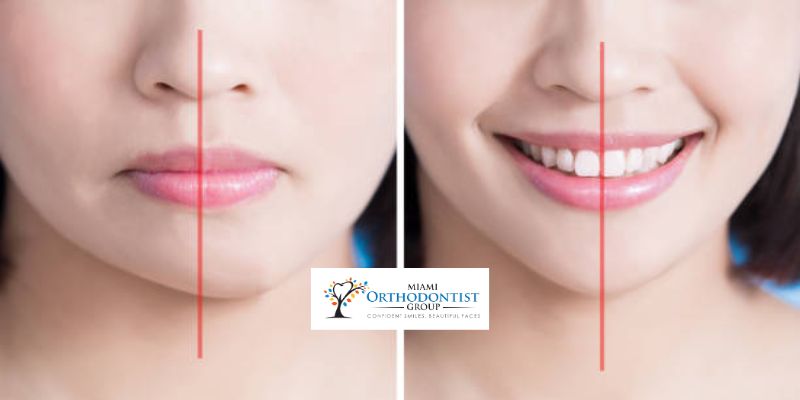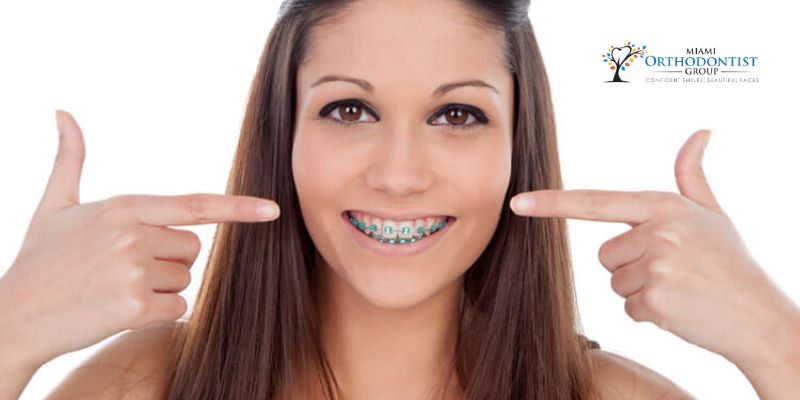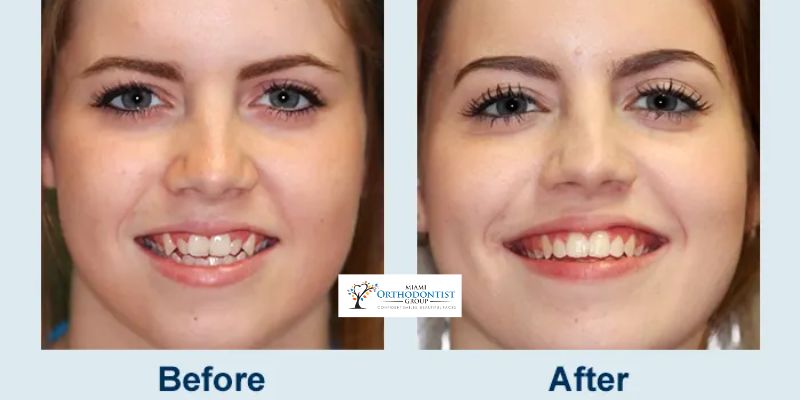Dentofacial orthodontics stands out as a specialized area focused on correcting misalignments within the teeth and the overall structure of the face. Dentofacial orthodontics goes beyond traditional orthodontic treatments, considering the interplay between the teeth, jaws, and facial structure to achieve optimal function and aesthetics. This holistic approach addresses dental alignment and issues related to facial symmetry, jaw positioning, and overall facial harmony.
The Role of Dentofacial Ortho in Correcting Facial and Dental Misalignments
Enhancing Facial Symmetry and Harmony
One of the primary roles of dentofacial orthodontics is to enhance facial symmetry and harmony. By evaluating the relationship between the teeth, jaws, and facial structure, dentofacial orthodontists can identify discrepancies that contribute to an unbalanced appearance. Through a combination of orthodontic appliances, such as braces or aligners, and sometimes surgical interventions, they work to correct these discrepancies, creating a more harmonious facial profile. This may involve adjusting the position of the teeth to align with the natural contours of the face and repositioning the jaws to achieve proper balance and proportion.
Furthermore, dentofacial orthodontics can address underbites, overbites, and crossbites, which affect dental alignment, facial aesthetics, and function. By correcting these malocclusions, dentofacial orthodontists can improve the smile’s appearance and functionality, enhancing overall facial aesthetics and boosting self-confidence.
Improving Dental Functionality and Bite Alignment
Another crucial role of dentofacial orthodontics is to improve dental functionality and bite alignment. Misalignments within the teeth and jaws can lead to various functional issues, including difficulty chewing, speaking, and maintaining proper oral hygiene. Dentofacial orthodontists can identify and address these issues by carefully analyzing the relationship between the teeth and jaws to restore optimal dental function.
Through the use of orthodontic appliances, such as braces or clear aligners, dentofacial orthodontics aims to gradually shift the teeth into proper alignment, ensuring a balanced bite and occlusion. This improves chewing efficiency and reduces the risk of developing dental problems such as tooth decay, gum disease, and temporomandibular joint disorders (TMJ). Additionally, by aligning the teeth and jaws correctly, dentofacial orthodontics can alleviate excessive wear and tear on the teeth, preserving their longevity and overall oral health.
Facial Harmony and Symmetry
 One of the primary goals of dentofacial orthodontics is to enhance facial harmony and symmetry by optimizing the relationship between the teeth, jaws, and surrounding soft tissues. Facial aesthetics play a crucial role in overall self-confidence and social interactions, and even minor discrepancies in tooth alignment or jaw position can significantly impact a person’s appearance. Dentofacial orthodontists carefully evaluate facial proportions, lip support, smile arc, and midline alignment to determine each patient’s most suitable treatment approach.
One of the primary goals of dentofacial orthodontics is to enhance facial harmony and symmetry by optimizing the relationship between the teeth, jaws, and surrounding soft tissues. Facial aesthetics play a crucial role in overall self-confidence and social interactions, and even minor discrepancies in tooth alignment or jaw position can significantly impact a person’s appearance. Dentofacial orthodontists carefully evaluate facial proportions, lip support, smile arc, and midline alignment to determine each patient’s most suitable treatment approach.
By correcting dental and skeletal discrepancies, dentofacial orthodontics can improve the alignment of the teeth and enhance the overall balance and proportion of the face. This may involve repositioning the jaws to achieve proper occlusion (bite) and facial symmetry, which can transform a person’s appearance. Through meticulous planning and advanced techniques, dentofacial orthodontists strive to create natural-looking smiles that complement the individual’s unique facial features, resulting in a more confident and aesthetically pleasing appearance.
Functional Optimization: Improving Oral Health and Functionality
Beyond the cosmetic benefits, dentofacial orthodontics is crucial in optimizing oral health and functionality. Misaligned teeth and jaws can contribute to various dental issues, including difficulty chewing, speech impediments, and an increased risk of tooth decay and gum disease. By correcting these malocclusions, dentofacial orthodontists help alleviate discomfort and improve overall oral function, leading to better oral hygiene and a reduced risk of dental problems in the long term.
Furthermore, properly aligned teeth and jaws promote more efficient chewing and digestion, positively affecting overall health and nutrition. Dentofacial orthodontics can help prevent excessive wear and tear on the teeth and reduce the risk of temporomandibular joint (TMJ) disorders by ensuring the teeth come together properly and evenly distribute bite forces. This comprehensive approach to oral health enhances the patient’s quality of life and contributes to their overall well-being.
Psychosocial Impact: Boosting Confidence and Self-Esteem
 The psychological impact of dentofacial orthodontic treatment should be noticed. For many individuals, living with dental or facial misalignments can take a toll on self-confidence and self-esteem, leading to social anxiety and a reluctance to smile or engage in social activities. Dentofacial orthodontics improves the smile’s physical appearance and profoundly affects the patient’s emotional well-being.
The psychological impact of dentofacial orthodontic treatment should be noticed. For many individuals, living with dental or facial misalignments can take a toll on self-confidence and self-esteem, leading to social anxiety and a reluctance to smile or engage in social activities. Dentofacial orthodontics improves the smile’s physical appearance and profoundly affects the patient’s emotional well-being.
Dentofacial orthodontists help patients achieve a more symmetrical and attractive smile by correcting dental and facial discrepancies, boosting confidence and self-esteem. Feeling proud of their smile, patients are more likely to smile openly, communicate confidently, and engage in social interactions without reservation. This newfound confidence can have far-reaching effects on various aspects of life, including personal relationships, academic and professional success, and overall happiness and fulfillment.
Emerging Trends in Dentofacial Orthodontics
As technology advances, dentofacial orthodontics is witnessing the emergence of innovative techniques and tools that enhance treatment outcomes and patient experiences. One notable trend is the increasing use of digital technology in treatment planning and delivery. Digital impressions, cone-beam computed tomography (CBCT) scans, and 3D imaging allow dentofacial orthodontists to obtain detailed anatomical information, enabling more precise diagnosis and treatment planning. Moreover, computer-aided design and manufacturing (CAD/CAM) technology facilitates the fabrication of customized orthodontic appliances, such as clear aligners and lingual braces, tailored to each patient’s unique dental anatomy.
Another promising trend in dentofacial orthodontics is the integration of interdisciplinary treatment approaches. Collaboration between orthodontists, oral surgeons, periodontists, and other dental specialists allows for comprehensive care of complex cases involving both dental and skeletal discrepancies. This team-based approach ensures that all aspects of the patient’s oral health and facial aesthetics are addressed, leading to more predictable outcomes and improved patient satisfaction.
Additionally, a growing emphasis is on minimally invasive techniques in dentofacial orthodontics. Techniques such as temporary anchorage devices (TADs) and accelerated orthodontic treatment modalities enable shorter treatment times and reduced patient discomfort. Furthermore, biomechanics and materials science advancements have developed low-friction brackets, heat-activated wires, and other orthodontic appliances that minimize friction and discomfort during tooth movement.
Conclusion
In conclusion, dentofacial orthodontics is a dynamic and evolving field that continues to evolve in response to technological advancements and changing patient demographics. From digital treatment planning and interdisciplinary collaboration to minimally invasive techniques and specialized care for patients of all ages, dentofacial orthodontists are at the forefront of innovation, striving to deliver optimal outcomes and improve the lives of their patients.


